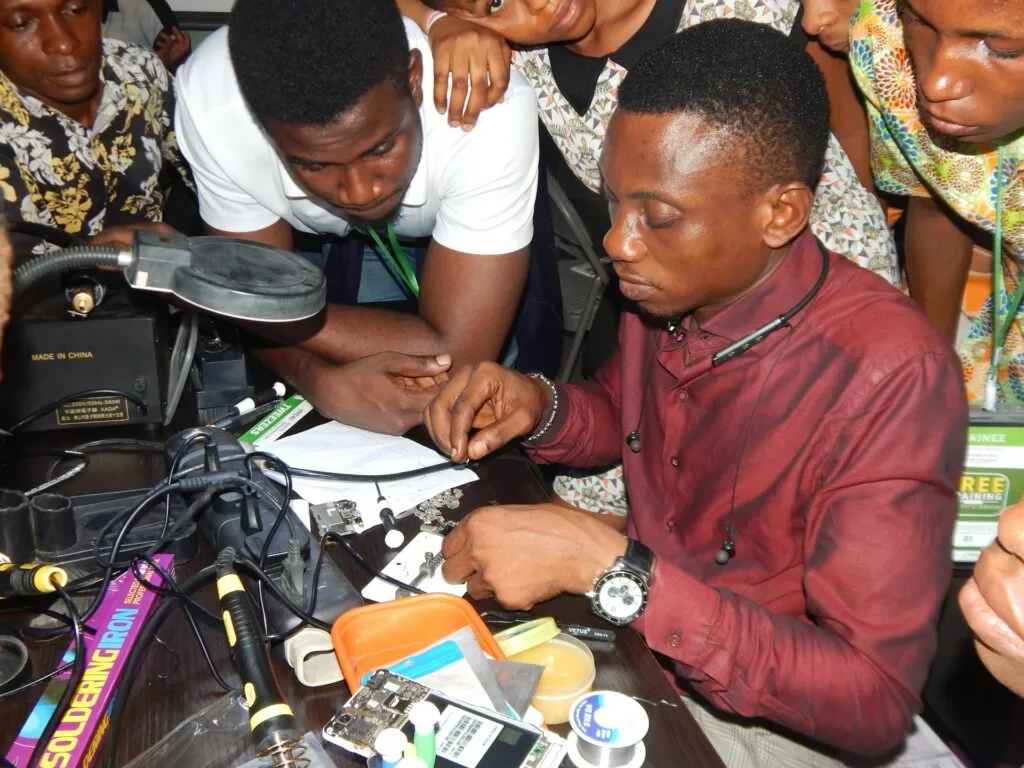Happy Eco News The African Solar Repair Movement: Fixing the Future of Renewable Energy
Reading Time: 3 minutes
With millions of solar devices failing, the African solar repair movement is training local technicians to extend their lifespan.
Africa’s solar energy boom has changed lives, bringing power to millions without electricity access. However, as solar equipment ages, a growing number of systems are breaking down. Without repair services, communities risk losing their only source of power.
A growing network of solar repair entrepreneurs is working to fix this problem. Known as the African solar repair movement, this initiative trains local technicians to restore broken solar devices, extending their lifespan and keeping power accessible in off-grid areas. Experts say this approach is crucial for creating a sustainable solar economy.
Solar energy has expanded rapidly across Africa over the past decade. In 2014, the continent had just 1.67 gigawatts of solar capacity. By 2023, that number had grown nearly tenfold to 13.48 gigawatts—enough to power 100 million lightbulbs.
Africa is an ideal location for solar energy. According to the International Energy Agency, the continent has 60% of the world’s best solar resources. In many areas, solar is already the cheapest way to generate electricity.
However, as more solar devices are installed, a new problem has emerged: maintenance and repair. Solar products such as home lighting kits and mini-grids are breaking down; without proper servicing, they become waste.

According to SolarAid, a nonprofit focused on solar access in Africa, over 250 million solar energy kits worldwide have fallen into disrepair. In sub-Saharan Africa alone, 75% of all solar products—an estimated 110 million solar lights—no longer work.
Most of these devices could be fixed with simple repairs. However, because there is little infrastructure for solar maintenance, broken systems are often discarded.
This creates three major problems. One is the loss of access to electricity. Many communities depend entirely on solar power. When systems fail, families are left in the dark.
Two, electronic waste accumulation. Non-repairable solar devices contribute to Africa’s growing e-waste problem.
Finally, there is economic loss. Solar products are expensive for African households, and replacing them frequently is not sustainable.
To address this crisis, organizations like SolarAid have launched programs to train local repair agents. These entrepreneurs, often called “solar repair agents,” learn to diagnose and fix common solar equipment failures, such as faulty batteries, wiring issues, and broken switches.
Father Vincent Ngwira, a Catholic priest in Zambia, is one of these repair agents. He has been involved in solar energy distribution since 2017 and recently completed a three-day training program to repair solar devices in his community.
“In the past, people used candles for light, and that led to house fires,” says Ngwira. “Solar changed everything, but now many of these devices are breaking. Learning to repair them has been empowering.”
In September 2023, he fixed a faulty solar panel and a broken flashlight switch. The flashlight repair cost just 20 Zambian Kwacha ($0.75)—a price that makes solar maintenance affordable for even the poorest households.
The African solar repair movement does more than keep the lights on. It also provides economic and environmental benefits: Repair technicians and solar entrepreneurs gain new income opportunities. Repairing solar devices prevents unnecessary e-waste, and keeping money within communities instead of spending on new imports strengthens financial resilience.
In Zambia, 10 repair agents and 7 advanced technicians are now fixing more complex solar failures. SolarAid teams in Zambia and Malawi have repaired over 2,400 solar products in the past year.
“We’re creating a sustainable solar economy,” says Fred Mwale, project manager for SolarAid in Zambia. “Repairing devices instead of replacing them benefits both people and the planet.”
Despite its success, the African solar repair movement faces several challenges.
One is that spare parts are limited. Many solar batteries and components must be imported from China, which can take months. Manufacturers also limit access to repair information to protect their designs.
Two, repair shops must be centrally located in rural areas to be accessible. Some people still have to travel long distances to reach them.
Finally, Zambia alone has 72 spoken languages, making communication difficult for technicians working in remote villages.
Mwale believes that the movement can overcome these obstacles with better support. “We need manufacturers to make spare parts more available and governments to support repair-friendly policies,” he says.
Other renewable energy sources, such as wind power, also face maintenance challenges. However, large-scale wind and hydroelectric projects are usually managed by corporations with dedicated repair teams.
Solar, on the other hand, is often distributed through small-scale systems to individual households. This makes community-based repair models like the African solar repair movement even more essential.
The future of the African solar repair movement looks promising. With better policies and funding, experts predict that solar repair could expand across the continent.
Innovations like 3D-printed solar components and community repair hubs could make repairs even more accessible. Governments may also introduce policies that require manufacturers to provide repairable designs and spare parts.
With Africa’s demand for solar energy increasing, a strong repair network will be essential to powering the continent.
The African solar repair movement is proving that renewable energy isn’t just about installing new systems—it’s about keeping them running for generations. As Africa pushes toward sustainable and affordable energy for all, repair initiatives will play a crucial role in shaping the future.
The post The African Solar Repair Movement: Fixing the Future of Renewable Energy appeared first on Happy Eco News.
